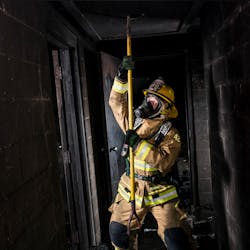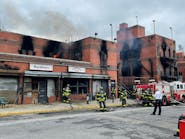Sometimes, the firefighting glove is considered nothing more than a low-bid commodity. However, in actuality, it has a wide range of characteristics and duties that it must fulfill. It must protect you from the heat and flame of the fire and from heated objects. It must allow you to perform your job with dexterity and function while it protects you.
That said, protection versus fit and function is a delicate balance. Protection requirements are rather equal across the board, because the more thermal protection that you put into a glove, the potentially less functionality that the user will enjoy. So, despite the fact that better engineering has been incorporated into firefighting gloves recently, no matter how they feel when you first put them on, you always should evaluate them under firefighting conditions as well as in regard to how they hold up from advanced cleaning following use or contamination.
The basics
It’s a theme for all evaluations: form a committee.
In conjunction with and independent of a committee that you form, do mass amounts of research. There’s a significant amount of knowledge to be gleaned online, including from other departments based on their experiences with gloves.
Let your firefighters tell you what they like and don’t like about gloves that are being evaluated and to make suggestions. In other words, have some firehouse focus groups. The informal settings seem to breed the most open communication.
Always wash and dry the gloves that you evaluate the way that your firefighters will.
Always cut open gloves that you evaluate to see how they reacted to exposure to moisture, to see whether there are breaches or separations or interior damage.
Have your firefighters try to put them back on after taking them off after usage.
Do realistic fireground dexterity evaluations:
- Change a radio channel or turn a channel selector
- Open pockets, retrieve items from pockets and use important pocket tools, such as wire cutters
- Deploy and attach the buddy breather
- Deploy, connect and disconnect everything that’s in the RIT bag
- Connect an extra section of hose
- Deploy a search rope
- Use all of the tools
- Connect to a standpipe
Although numerous excellent fabrics and leather products are used in the outside covering of gloves, one issue that always seems to emerge is the grip of a firefighting glove when it’s wet. Firefighters work in a wet environment, and having a slick palm and grip is a hazard to that firefighter and those who are around that firefighter. Pay close attention to grip during staged, live fire evolutions and field trials.
Here’s a potential template to solicit gloves for an evaluation:
“The evaluation for the structural firefighting glove is planned to begin no later than (date) and conclude upon completion or when (Name) Fire Department is satisfied that it fully evaluated the submitted products, to properly assess all aspects of gloves, including fit, function and durability.
Note: The phrase “conclude upon completion” doesn’t tie your hands with external dates even though internally you might set a date for the process’ completion.
All manufacturers that produce their products in (the United States, etc.) are invited to participate. The following parameters will apply to all products and all participants:
- A minimum of (quantity) of each product shall be submitted. Only (type) style may be submitted per manufacturer.
Note: Of course, manufacturers have different styles. Do you want their “best performing” model? Their two best performing models? Their best and their low bid winner?
- Of the (quantity) submitted pairs of gloves, one randomly selected pair may be used for destructive testing and examination by (Name) Fire Department.
- All products must meet all of the current requirements of NFPA 1971: Standard on Protective Ensembles for Structural Firefighting and Proximity Fire Fighting.
Note: The barrier product that keeps bloodborne pathogens, water, hydrocarbon fluids (gasoline, hydraulic fluid, etc.), chlorine and battery acid off of your skin is terribly important. A few years back, it was discovered by accident in a different testing scenario that a certain glove barrier was melting with exposure to certain hydraulic fluids. Imagine if that issue wasn’t discovered.
- Participating manufacturers will ensure that correct sizing is provided for each evaluator who wears the manufacturer’s product.
Note: This is extremely important. If you have evaluators who have special requirements or sizing, including them is a way to test the manufacturer’s capabilities.
- Participating manufacturers must ensure that training is provided to meet any applicable aspects of NFPA 1851: Standard on the Selection, Care, and Maintenance of Protective Ensembles for Structural Fire Fighting and Proximity Fire Fighting.
- Before being accepted to participate, a letter from a certified third-party testing laboratory that states that the models of the manufacturer’s product were tested and meets the requirements that are set forth in NFPA 1971 must be provided.
- Any style, seam, stitching, design concept and innovation that’s already included as part of the current (Name) Fire Department specification should take precedent in the construction of the gloves that are submitted unless an approved equal or alternative is allowed by (Name) Fire Department.
- All products that are submitted and accepted for evaluation become the property of the (Name) Fire Department at no cost or expense to the (Name) Fire Department.”
Make sure that firefighters who are assigned to different rigs/duties use the gloves. If you have a limited amount of time to evaluate, use a burn building evolution to accelerate the wear of the glove. As with anything else, it’s ideal if each evaluator can test each pair of gloves that are submitted. That said, it isn’t practical to expect that each glove would be subjected to the same runs and conditions each time that it’s worn. If evaluators are on the same apparatus or are assigned to the same firehouse, you will get experience-based comparisons and product discussion. Also, theoretically, the gloves that are being worn by firefighters in the same firehouse, on the same shift or on the same rig likely will be subjected more to the same incidents and conditions.
As is the case with anything else that firefighters wear, purchasing gloves on first impression or sales pitch might work for administrators, résumé builders and budget people, but when firefighters wear them and depend on them, firefighters should have the majority, if not total, decision in which gloves to acquire and to use.









